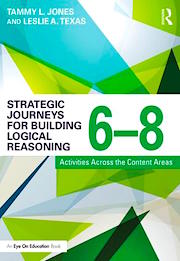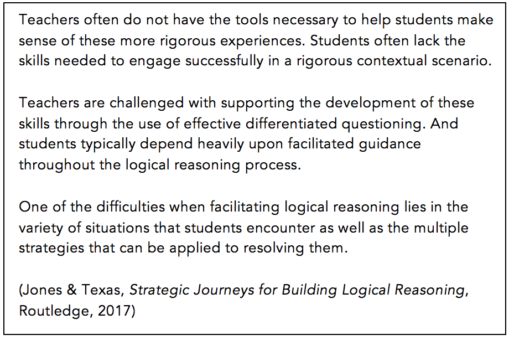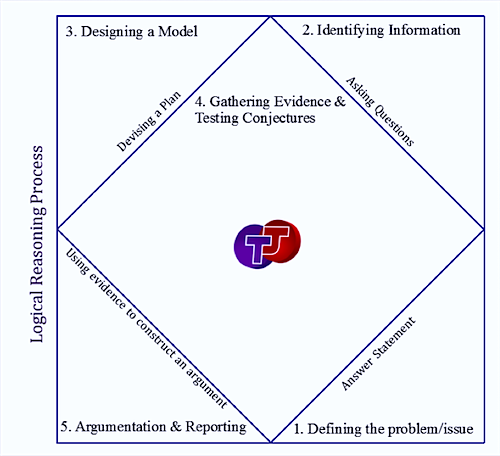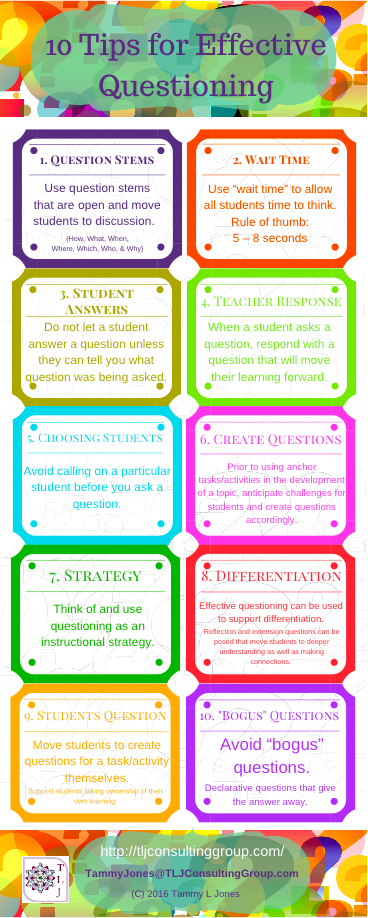Helping Students Develop Logical Reasoning
Middle school teachers have it tough.
They’re faced with the task of making today’s more rigorous standards accessible to all learners. At the same time, more emphasis is being placed on communication, both verbal and written, and on logical reasoning.
To add to the challenge, we are often working with students who come into middle school with significant gaps in their prior learning. And how do we push our students who are on the upper end of achievement in this era when growth is so important?
My colleague Leslie Texas and I propose a three-prong approach to supporting students in their daily journey through the content they are learning.
(1) Using questioning effectively;
(2) Integrating authentic opportunities for writing, and
(3) Providing a bridging structure for students to use as they encounter new situations where critical thinking is required.
Whether it is a contextual problem to solve in mathematics, a scientific investigation to perform, a piece of text to analyze, or interpreting historical events – students are engaging in logical reasoning.
Planning lessons that promote logical reasoning
As teachers plan they look at the standards for the content they teach and think about the large overarching topics that are foundational to their specific grade/subject. For each of those foundational topics teachers should have a few anchor tasks, activities, and/or investigations that provide meaningful experiences for their students.
These tasks and investigations are fundamental in supporting the development of logical reasoning, making connections, and building understanding. When planning these tasks or investigations, teachers need to be deliberate and intentional so their instruction is impactful, consistent, and effective.
The planning should include a variety of opportunities for students to communicate through original thought writing, purposeful discourse, and effective questioning.
One bridging structure that supports this challenge is the Logical Reasoning Process graphic organizer.
This graphic organizer (LRP) provides a scaffold for students as they encounter new situations in the content they are investigating. Students begin the process by defining a problem, an issue, or a dilemma. Students should be able to frame the task that is being posed in an answer statement format.
Teachers should not allow students to answer a question without the student first being able to state what is being asked.”
The next step in the process: Knowing and being able to identify pertinent information as well as understanding if there is more information that needs to be gathered. These two steps are where students are first entering the task/activity and for some it’s where they first encounter a roadblock.
Developing a strategy
From here students being to develop a strategy, design a model, and/or devise a plan. This is where many educators encounter the question from students, “Can you just tell me what to do to get started?” Moving from the second part of the process to this third is where many students get stuck. This is where effective questioning on the part of the teacher can provide much needed support. More on that later.

Inherent in this process of “work” is students gathering evidence to support what they are doing. If during the course of their work students find that this particular strategy, model, or plan is not getting them to the desired outcome, they move back out to the previous step and seek an alternative to their first choice.
It is very important that students have this productive struggle to help them develop their logical reasoning skills as well as perseverance. Once students feel they have successfully reached the desired outcome (a strategy or plan), they move to creating a viable argument, citing evidence in support of their work. This is the time for students to reflect on their work and check for reasonableness in their solution. Students then present and defend their work (Step 5 in the LRP).
Communication skills
The importance of communication is stressed by organizations representing each of the academic disciplines. Students are expected to justify their solutions and conclusions as well as critique the reasoning of their peers.
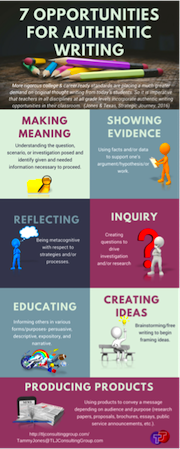
Middle school students are taking a journey through each of their subjects. Keeping a Journey’s Notebook is one way students can chronicle their journey. The notebook becomes a dynamic place where language, data, and logical reasoning experiences operate jointly to form meaning for the middle school student.
The Journey’s Notebook helps students create an organized space for demonstrating their learning process. The notebook serves as a formative instructional tool as well as a portfolio of the students’ learning experiences, which provides rich documentation of their critical thinking development.
Writing about your thinking is one of the main shifts in today’s instruction and the next generation of assessments. In all disciplines there exist seven opportunities for authentic writing. This list is neither linear nor cyclical because these are interconnected more often than not in the classroom.
The seven opportunities (click poster to download) are:
► Making Meaning – understanding the question/task posed and identifying given and needed information necessary to proceed.
► Showing Evidence – using facts and/or data to support one’s argument/hypothesis/or work they are doing.
► Reflecting – being metacognitive with respect to strategies and/or processes.
► Inquiry – creating questions to drive investigation and/or research
► Educating – informing others in various forms/purposes – persuasive, descriptive, expository, and narrative.
► Creating Ideas – brainstorming/free writing to begin framing ideas.
► Producing Products – using products to convey a message depending on audience and purpose.
One advantage of these opportunities for writing is that they can easily be modified and differentiated to meet the needs of all learners no matter their grade or level. The National Literacy Association and the National Council of Teachers of English have a website ReadWriteThink that can be a valuable resource for teachers of any discipline who want to incorporate more writing into their daily instruction.
Avoiding bogus questions
Another challenge that teachers face is moving students and their learning forward without “spoon feeding.” Too often educators ask “bogus” questions that are really just declarative statements that include the answer but are framed as a question.
Students are experts in picking up on these empty teacher statements. When students are engaged in authentic logical reasoning experiences, there are four opportunities for effective questioning.
- Entry: for students having difficulty getting started.
- Moving: for places where students could get stuck.
- Reflection: for students to use for metacognition (after completing problem/issue).
- Extension: for students to engage in higher-order thinking skills with respect to the same concept and/or problem.
As teachers, we should first complete our own anchor tasks, activities, and investigations from the perspective of a student. This should give us ideas where students will encounter challenges – anything from vocabulary to gaps in prior knowledge.
Teachers should then create questions for these anchor experiences that will help move students forward – no matter where they are in the process.
My “10 Tips for Effective Questioning” is just as valuable for teachers as it is for students. The goal for teachers is to create self-sufficient, life-long learners by equipping our students with the tools they need to be successful.
To learn more about these and other strategies and tools check out Strategic Journeys for Building Logical Reasoning: Activities across the Disciplines (available for grades K-5, 6-8, and 9-12). Each book includes authentic logic-building activities and writing strategies that can be used across all subject areas.
__________
